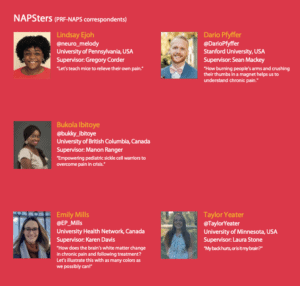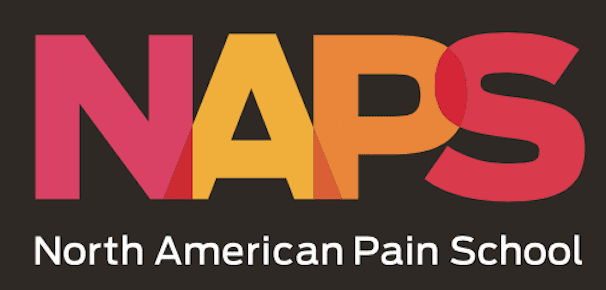Five early-career pain researchers are participating in the PRF-NAPS Correspondents program during the 2023 North American Pain School, taking place from 18-23 June in Montebello, Québec City, Canada. The Correspondents program is a unique science communication training program that provides participants with knowledge and skills needed to communicate science effectively to a wide range of pain researchers, patients, and the greater public. The Correspondents will conduct interviews with NAPS Visiting Faculty and Patient Partners, write summaries of scientific lectures – and provide live blogging too! Take a look at their blog posts from Day 2.
NAPS Day 2 Blog Posts
Striking a Balance in Pain Management
From Virtual Reality to BoriZafi
From Participants to Partners: A Painfully Needed Revolution
Striking a Balance in Pain Management
During the “Ask the Patient Partners” session today, one of our partners, Jennifer Daly-Cyr, described keeping a meticulous journal to track her pain. That concept is very scary to me.
I have struggled with chronic musculoskeletal pain for years, but I’m also a pain scientist who thinks about pain every single day. I’m terrified of catastrophizing – giving my pain too much attention and power over my life. I tend to try my best to ignore it. As a result, I struggle to remember the patterns and triggers associated with my pain – which impact my ability to advocate for myself during consults – and to take charge of my pain management.
After the session, I privately asked Jennifer and our other Patient Partner, Keith Meldrum, “As a person with lived experience, how do you monitor your pain symptoms without paying too much attention to your pain?”
Jennifer agreed that it can be maladaptive to think about her pain all the time, and has learned to take quick notes using the app Manage My Pain to have her health data in one place without spending too much time thinking about it. Then, Keith gave me life-changing advice through two points:
1) Your pain is a part of you that you cannot ignore. It does not define you; it is a thread that fits into the fabric of your life. You can’t ignore that.
2) In his experience, he was not able to effectively manage his pain until he acknowledged its existence and its role in his life.
I had a realization: I didn’t even consider my pain as a real issue until five years into experiencing pain on a daily basis – two years into starting my research career in the pain field! It was humbling to realize that I had been in denial for so long, and I’m still playing into some unhealthy ways of coping with and conceptualizing my pain. I’ve found it so exhausting to monitor my pain levels and advocate for myself in the clinic that I simply chose to avoid it – which hasn’t helped me in the long run.
I was moved to tears, and Jennifer and Keith hugged and encouraged me, assuring that I was heard. When I applied to NAPS, I was excited about the presence of Patient Partners, as it’s crucial for pain scientists to understand the perspectives and priorities of persons with lived experience. I could not imagine that their perspectives would be so validating for me and my journey with pain as well.
Lindsay Ejoh is a PhD candidate at the University of Pennsylvania, USA. You can follow her on Twitter – @neuro_melody.
From Virtual Reality to BoriZafi
I started my PhD work enthusiastic to explore the impact of virtual reality on sickle cell crisis pain in adolescents living with sickle cell disease. One day, I was discussing my research with a mentor, and she said, “Is that really what the patients want?” That question struck me.
What is the point of investing resources in an intervention for a group of people who might not want that intervention or find it useful? So I spoke to a former classmate who lives with sickle cell disease. She felt that virtual reality might be useful in this population; however, there may be challenges with patient recruitment and sustainability of use in the emergency room – especially in a low-resource setting.
Eventually, my supervisors and I decided the project might not be well suited for a doctoral project. As I searched for a new research direction, I decided to start by engaging those living with sickle cell disease and identifying the problems I could help to solve through my research.
I joined a Facebook support group for people living with sickle cell disease in Nigeria. This exposed me to their world. I saw questions like, “How do I massage my body? I am in pain, but I have been discharged from the hospital; I don’t know what to do. What do I do to stop this pain?”
I began to think of a website with videos and animations on how to perform safe, cost-effective, and effective non-pharmacological interventions that people living with sickle cell disease can perform without the support of trained personnel. Did one exist? This is how BoriZafi was born.
BoriZafi (overcoming pain) is a web-based pain management toolkit of various non-pharmacological interventions. The interventions that will be included will be selected by adolescents living with sickle cell disease. Through a robust selection system, those that are evidence based will be included. This project is being conducted with non-governmental organizations working with the sickle cell disease population, and their involvement improved participant recruitment in our ongoing survey.
Patient Partner perspectives shaped my research. I believe that clinical research should meet the patient’s needs, not only the researcher’s quest.
Bukola Ibitoye is a PhD candidate at the University of British Columbia, Canada. You can follow her on Twitter – @bukky_ibitoye.
As pain scientists, we strive to find better solutions for people living with pain. To that end, we need to understand what it means to live with pain, and how the patient defines an improvement in pain.
Seeking the expertise of people with lived experience (PWLE) is a necessary step in the translation of basic science to clinically meaningful research. Each person experiences pain in different ways, so there is variability in how people define treatment success. Through our lab’s research into treatment responsiveness, I have met PWLE who continued to experience high pain levels after treatment but felt the treatment was successful, nonetheless.
Why, since pain interfered less with their day-to-day life?
Consulting with Patient Partners to understand their pain experience and what “treatment success” really means to them, beyond the sometimes simplistic “pain intensity” measure, is critically important.
In saying this, we need to consider how we incorporate a person’s experience into a research project. This likely depends on the nature of what it is we are operationalizing. If certain aspects of their pain experience can be captured in questionnaires, such as “pain interference,” then this is a straightforward measure to include.
However, a challenge to consider more broadly is the question of heterogeneity and a person’s unique experience living with pain. While one person’s hope may be to return to daily activities, other PWLE – like our Patient Partner Jennifer Daly-Cyr – maintain that reducing pain intensity is their primary goal. In our research, we try to respect and capture this and other variability in our research population by developing extensive quantitative sensory testing batteries, administering many types of pain and psychological questionnaires, and profiling brain structure and function with multiple neuroimaging modalities.
The perspectives and experiences of our Patient Partners are critically important to incorporate in our future projects, and all pain researchers should carefully consider how to do this. After all, our research goals are their life goals.
Emily Mills is a postdoctoral researcher at the Krembil Brain Institute, University Health Network, Toronto, Canada. You can follow her on Twitter – @EP_Mills.
From Participants to Partners: A Painfully Needed Revolution
Our very first session during day two at NAPS was titled, “Ask the Patient Partners,” and it was stuck in my head the whole day.
NAPSters and Visiting Faculty got the chance to talk with Jennifer Daly-Cyr and Keith Meldrum, two wonderful, remarkable people suffering from life-changing chronic pain. Keeping in mind the (sometimes unbearable) pain they experience, I admire and appreciate how generous they’ve been to our pain research community. We should express our gratitude for Patient Partners like Jennifer and Keith by including them throughout every stage of a study.
While we’ve always verbally expressed our appreciation for the contributions offered by our Patient Partners, we often don’t give them an opportunity to help optimize study design or participate in the grant writing process.
Over the past few years, several academic institutions – and hopefully many more to follow – have successfully revolutionized the role of Patient Partners in clinical studies. My own project would fail to be as rigorous without my Patient Partners. Thanks to all the “Jennifers” and “Keiths” around the world!
Dario Pfyffer is a postdoctoral research scholar at Stanford University, California, USA. You can follow him on Twitter – @DarioPfyffer.
When Jeff Mogil asked for a few postdoctoral researchers to volunteer to have their presentations be critiqued by a roomful of scientists, I ignored the email. Perhaps it was imposter syndrome at first. When he asked a second time, I decided to go for it.
Today was the day. After a deep breath, I followed a gut instinct and started with a joke. A joke! What was I doing? This was a serious workshop. I thought, “Jeff Mogil can make jokes, but surely I shouldn’t.” Then the best possible outcome occurred – everyone laughed. The imposter syndrome melted away as I went through a few more slides, and started to receive comments on my presentation style.
I was excited when much of the positive feedback I received was on my personality, my cadence, and my humor. I felt invigorated. I enjoy communicating science and engaging an audience. That’s a big reason I wanted to be a PRF-NAPS Correspondent.
I’ve been thinking about getting more involved in science communication, but I’ve been unsure how to get started. This led me to join Rachael Bosma and others at lunch today to discuss alternative career paths. The overwhelming consensus from us trainees at the table was the anxiety induced by the uncertainty in these alternative paths.
The truth is, many trainees are hesitant to discuss alternative career paths with their academic mentors. I don’t think it has anything to do with a lack of support from our academic mentors (I have great mentors!), but perhaps a lack of mentors outside of academia. People who understand the options a bit more, and empower us to make brave choices and follow our gut, even if it is the road less taken.
Today, I did something brave. And who knows? Tomorrow I could do something brave as well!
Taylor Yeater is a postdoctoral fellow at the University of Minnesota, USA. You can follow her on Twitter – @TaylorYeater.
The 2023 PRF-NAPS Correspondents



